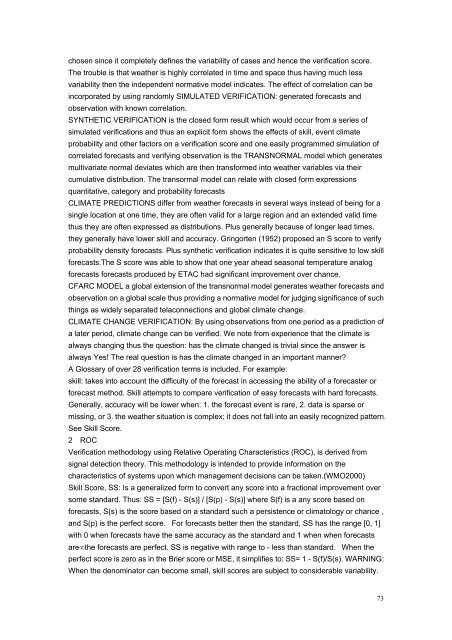The tenth IMSC, Beijing, China, 2007 - International Meetings on ...
The tenth IMSC, Beijing, China, 2007 - International Meetings on ...
The tenth IMSC, Beijing, China, 2007 - International Meetings on ...
You also want an ePaper? Increase the reach of your titles
YUMPU automatically turns print PDFs into web optimized ePapers that Google loves.
chosen since it completely defines the variability of cases and hence the verificati<strong>on</strong> score.<br />
<str<strong>on</strong>g>The</str<strong>on</strong>g> trouble is that weather is highly correlated in time and space thus having much less<br />
variability then the independent normative model indicates. <str<strong>on</strong>g>The</str<strong>on</strong>g> effect of correlati<strong>on</strong> can be<br />
incorporated by using randomly SIMULATED VERIFICATION: generated forecasts and<br />
observati<strong>on</strong> with known correlati<strong>on</strong>.<br />
SYNTHETIC VERIFICATION is the closed form result which would occur from a series of<br />
simulated verificati<strong>on</strong>s and thus an explicit form shows the effects of skill, event climate<br />
probability and other factors <strong>on</strong> a verificati<strong>on</strong> score and <strong>on</strong>e easily programmed simulati<strong>on</strong> of<br />
correlated forecasts and verifying observati<strong>on</strong> is the TRANSNORMAL model which generates<br />
multivariate normal deviates which are then transformed into weather variables via their<br />
cumulative distributi<strong>on</strong>. <str<strong>on</strong>g>The</str<strong>on</strong>g> transormal model can relate with closed form expressi<strong>on</strong>s<br />
quantitative, category and probability forecasts<br />
CLIMATE PREDICTIONS differ from weather forecasts in several ways instead of being for a<br />
single locati<strong>on</strong> at <strong>on</strong>e time, they are often valid for a large regi<strong>on</strong> and an extended valid time<br />
thus they are often expressed as distributi<strong>on</strong>s. Plus generally because of l<strong>on</strong>ger lead times,<br />
they generally have lower skill and accuracy. Gringorten (1952) proposed an S score to verify<br />
probability density forecasts. Plus synthetic verificati<strong>on</strong> indicates it is quite sensitive to low skill<br />
forecasts.<str<strong>on</strong>g>The</str<strong>on</strong>g> S score was able to show that <strong>on</strong>e year ahead seas<strong>on</strong>al temperature analog<br />
forecasts forecasts produced by ETAC had significant improvement over chance.<br />
CFARC MODEL a global extensi<strong>on</strong> of the transnormal model generates weather forecasts and<br />
observati<strong>on</strong> <strong>on</strong> a global scale thus providing a normative model for judging significance of such<br />
things as widely separated telac<strong>on</strong>necti<strong>on</strong>s and global climate change.<br />
CLIMATE CHANGE VERIFICATION: By using observati<strong>on</strong>s from <strong>on</strong>e period as a predicti<strong>on</strong> of<br />
a later period, climate change can be verified. We note from experience that the climate is<br />
always changing thus the questi<strong>on</strong>: has the climate changed is trivial since the answer is<br />
always Yes! <str<strong>on</strong>g>The</str<strong>on</strong>g> real questi<strong>on</strong> is has the climate changed in an important manner?<br />
A Glossary of over 28 verificati<strong>on</strong> terms is included. For example:<br />
skill: takes into account the difficulty of the forecast in accessing the ability of a forecaster or<br />
forecast method. Skill attempts to compare verificati<strong>on</strong> of easy forecasts with hard forecasts.<br />
Generally, accuracy will be lower when: 1. the forecast event is rare, 2. data is sparse or<br />
missing, or 3. the weather situati<strong>on</strong> is complex; it does not fall into an easily recognized pattern.<br />
See Skill Score.<br />
2 ROC<br />
Verificati<strong>on</strong> methodology using Relative Operating Characteristics (ROC), is derived from<br />
signal detecti<strong>on</strong> theory. This methodology is intended to provide informati<strong>on</strong> <strong>on</strong> the<br />
characteristics of systems up<strong>on</strong> which management decisi<strong>on</strong>s can be taken.(WMO2000)<br />
Skill Score, SS: Is a generalized form to c<strong>on</strong>vert any score into a fracti<strong>on</strong>al improvement over<br />
some standard. Thus: SS = [S(f) - S(s)] / [S(p) - S(s)] where S(f) is a any score based <strong>on</strong><br />
forecasts, S(s) is the score based <strong>on</strong> a standard such a persistence or climatology or chance ,<br />
and S(p) is the perfect score. For forecasts better then the standard, SS has the range [0, 1]<br />
with 0 when forecasts have the same accuracy as the standard and 1 when when forecasts<br />
are∞the forecasts are perfect. SS is negative with range to - less than standard. When the<br />
perfect score is zero as in the Brier score or MSE, it simplifies to: SS= 1 - S(f)/S(s). WARNING:<br />
When the denominator can become small, skill scores are subject to c<strong>on</strong>siderable variability.<br />
73






![final_program_abstracts[1]](https://img.yumpu.com/19102520/1/174x260/final-program-abstracts1.jpg?quality=85)









